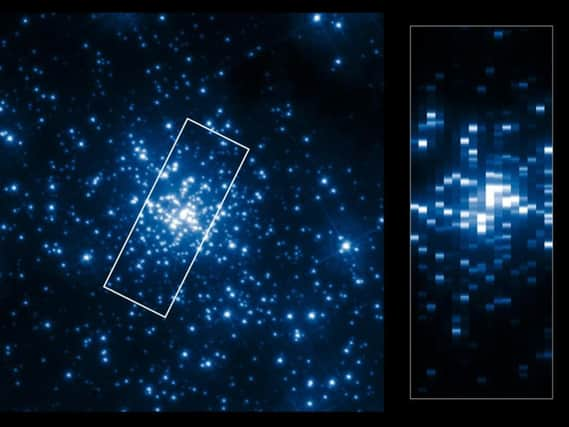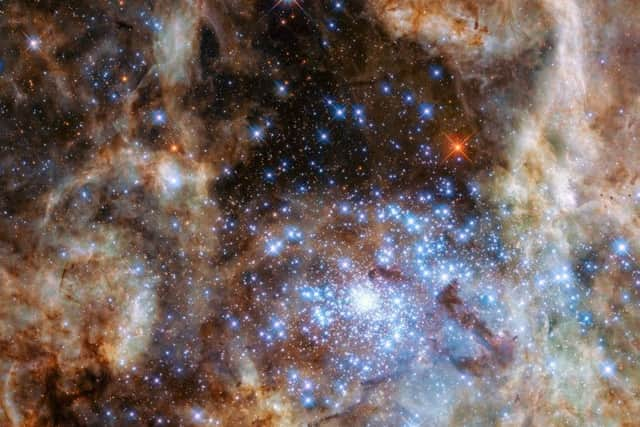SPACE DISCOVERY: University of Sheffield help find new 'monster' stars
This article contains affiliate links. We may earn a small commission on items purchased through this article, but that does not affect our editorial judgement.


It is the largest group of massive stars identified to date and the nine stars - located 170,000 light years away - outshine the Sun by a factor of 30 million.
The announcement comes just a month after scientists at the University of Sheffield helped to make one of the biggest space discoveries of all time, proving Albert Einstein's 100-year-old theory of general relativity was right.
Advertisement
Hide AdAdvertisement
Hide AdThey helped to find the first space distorting gravitational waves, which looks set to unlock the wonders of the universe with a form of new Gravitational Wave astronomy. Full story link below.
Today's announcement is another major discovery. The nine star cluster, named R136, is the largest sample of what are know as very massive stars to be identified to date and has raised many new questions about the formation of such stars.
The international team of scientists, led by researchers from the University of Sheffield, combined images taken with the Wide Field Camera 3 with the unprecedented ultraviolet spatial resolution of the Space Telescope Imaging Spectrograph (STIS) to successfully dissect the young star cluster in the ultraviolet for the first time.
R136 is only a few light-years across and is located in the Tarantula Nebula within the Large Magellanic Cloud about 170,000 light-years away. The young cluster hosts many extremely massive, hot and luminous stars whose energy is mostly radiated in the ultra violet – which is why the scientists probed the ultraviolet emission of the cluster.
Advertisement
Hide AdAdvertisement
Hide AdAs well as finding a total of nine very massive stars, over 100 times more massive than the sun, the new study also revealed dozens of stars exceeding 50 solar masses.


The detected stars are not only extremely massive, but also exceptionally bright and together the nine massive stars outshine the Sun by a factor of 30million.
Professor Paul Crowther, from the University of Sheffield’s Department of Physics and Astronomy and lead author of the study, said: “Once again, our work demonstrates that, despite being in orbit for over 25 years, there are some areas of science for which Hubble is still uniquely capable.
“The ability to distinguish ultraviolet light from such an exceptionally crowded region into its component parts, resolving the signatures of individual stars, was only made possible with the instruments aboard Hubble.
Advertisement
Hide AdAdvertisement
Hide Ad“Together with my colleagues, I would like to acknowledge the invaluable work done by astronauts during Hubble’s last servicing mission: they restored STIS and put their own lives at risk for the sake of future science.”


In 2010 Professor Crowther and international team of collaborators showed the existence of four stars within R136, each with over 150 times the mass of the sun. At that time the extreme properties of these stars came as a surprise as they exceeded the upper-mass limit for stars that was generally accepted at the time.
Now, this census, published in the monthly notices of the Royal Astronomical Society, has shown that there are five more stars with more than 100 solar masses in R136 raising many new questions about the formation of massive stars as the origin of these huge creations remains unclear.
Saida Caballero-Nieves, also from the University of Sheffield and co-author of the study, said: “There have been suggestions that these monsters result from the merger of less extreme stars in close binary systems. From what we know about the frequency of massive mergers, this scenario can’t account for all the really massive stars that we see in R136, so it would appear that such stars can originate from the star formation process.”
Advertisement
Hide AdAdvertisement
Hide AdIn order to find answers about the origin of these stars the team will continue to analyse the datasets gathered. An analysis of new optical STIS observations will also allow them to search for close binary systems in R136, which could produce massive black hole binaries which would ultimately merge, producing gravitational waves.
Despite the new discovery the current record holder R136a1 does keep its place as the most massive star known in the Universe at over 250 solar masses.
The Hubble Space Telescope is a project of international cooperation between ESA and NASA.
READ MORE:
MAJOR SPACE DISCOVERY: Sheffield University helps unlock new wonders of the universeRead more: http://www.thestar.co.uk/news/major-space-discovery-sheffield-university-helps-unlock-new-wonders-of-the-universe-1-7728577#ixzz43Aghgecz
Advertisement
Hide AdAdvertisement
Hide AdWith almost 27,000 of the brightest students from over 140 countries, learning alongside over 1,200 of the best academics from across the globe, the University of Sheffield is one of the world’s leading universities.
A member of the UK’s prestigious Russell Group of leading research-led institutions, Sheffield offers world-class teaching and research excellence across a wide range of disciplines. Unified by the power of discovery and understanding, staff and students at the university are committed to finding new ways to transform the world we live in.
Sheffield is the only university to feature in The Sunday Times 100 Best Not-For-Profit Organisations to Work For 2016 and was voted number one university in the UK for Student Satisfaction by Times Higher Education in 2014.
In the last decade it has won four Queen’s Anniversary Prizes in recognition of the outstanding contribution to the United Kingdom’s intellectual, economic, cultural and social life. Sheffield has five Nobel Prize winners among former staff and students and its alumni go on to hold positions of great responsibility and influence all over the world, making significant contributions in their chosen fields.
Advertisement
Hide AdAdvertisement
Hide AdGlobal research partners and clients include Boeing, Rolls-Royce, Unilever, AstraZeneca, Glaxo SmithKline, Siemens and Airbus, as well as many UK and overseas government agencies and charitable foundations.
For further information, please visit www.sheffield.ac.uk. Follow on Twitter @sheffielduni and Faceboo at www.facebook.com/theuniversityofsheffield